City House of Correction / HM Prison, Holloway, London
In 1843, the Prison Committte of the City of London Court of Common Council published its report on proposals for a new prison )a bridewell or house of correction)to replace the oneat Giltspur Street prison. The report concluded that on the grounds of cost, the need for a larger site, and the health considerations of the inmates, the new prison would have to be located outside the City. In April 1847, it was decided that the intended new prison should be erected at Holloway, on an eight-acre site belonging to the City in north London.
The new prison, erected in 1849-52, was designed by the City Architect, James Bunstone Bunning. It had 436 cells and followed the radial layout used at Pentonville. However, in contrast to the increasing popular 'separate system', which denied prisoners virtually all contact with one another, Holloway largely adopted the 'silent' system, where inmates had common workrooms, where they worked together in silence.
A contemporary account of the new building reported:
THE NEW CITY PRISON, HOLLOWAY.
The new prison, which has been built at Holloway for the Corporation of London, is constructed upon the radiating principle, having four wings diverging from one centre, with two other wings in front of the former: one of these wings is for juvenile offenders with schoolrooms attached; the other for females with work-rooms and laundry. The other four radiating wings constitute the male adult prison. These have large work-rooms attached, and an apparatus for lifting water. The wings are 12 cells in length, or about 100 feet, and 3 stories high. The corridors are 16 feet wide, and are open up to the arched ceiling, with galleries leading to the upper cells. The cells are 13 feet by 7 feet, fitted up with water-closets, wash-hand basin, cupboard, table, stool, &c.: these are warmed by means of hot water pipes laid under the corridor floor, the air passing over them and through the flues, provided in the thickness of the wall, and entering the cell over the door. The ventilation is to be effected by means of a shaft 146 feet high, of large dimensions. Inside this shaft is a tube of boiler 'plate the whole height of the shaft, 5 feet diameter at bottom, and 3 feet at top. In addition to a furnace at the bottom of the tube, the smoke from the various chimneys, together with the spare heat from the kitchen boilers, is conveyed into it, and will necessarily raise the temperature of the column of air in the shaft, and make it pass off with great rapidity. The theory is, that as no air can enter the shaft without previously passing through the cells, a constant supply of fresh air will thereby be conveyed to the prisoners.
The chapel is a spacious room 76 feet by 40, and 48 feet to the ridge of the roof, with two deep recesses for the females and juveniles, and will contain sittings for 380 prisoners. Provision is made for having a constant supply of fresh air passing through the chapel to the ventilating shaft. The arrangements for taking the prisoners from the various cells to the chapel have been well considered. The females and juveniles enter by separate doors near the altar, while the male prisoners enter by four different passages at the opposite end. The kitchen is of ample dimensions, and being close to the base of the ventilating shaft, the steam and smell from the victuals will be readily carried off. The well-house is to be fitted with one of Mr. Bessemer's disc pumps, and to be worked like a capstan, in a building 30 feet diameter. The shaft is 217 feet deep, bore 102 feet, making a total depth of 319 feet. The depth to the water is 153 feet. The tanks, to contain 14,000 gallons, are placed over the front towers at a great elevation, from which the cells and other places are supplied: the whole depth of bore is in chalk.
The whole extent of frontage next the Camden road is of Kentish rag with Caen stone dressings. The style is castellated Gothic. The sides of the chapel building and the back wings are of brick: the windows to the cells have Park-spring stone sills, with splayed brick reveals. The whole of the parapets are coped with Caen stone. The roofs are flat-covered with asphalte upon plain tiles and iron rafters. As the extracting flues for ventilation are immediately under the roof covering, two thicknesses of plain tiles have been put 6 inches apart, to prevent the atmosphere acting in any way against the free current of air passing through them.
The porter's lodge, which stands about 66 feet in front of the entrance building, is also of rag, with Caen stone dressings, and contains accommodation for two families. Between the last-named building and the road stand the two houses intended for the governor and chaplain, with large gardens attached.
The accommodation afforded in the prison is as follows:—
| Females | 60 | |
| Juveniles | 61 | |
| Male adults | 283 | |
| 404 | ||
| Reception cells | 14 | |
| Punishment ditto | 18 | |
| 436 | ||
with fourteen workrooms, equal to ninety-six cells; offices for the governor, chaplain, surgeon, steward, clerks, &c.; apartments for the surgeon and deputy-governor, and for master and two turnkeys in juvenile wing, matron and two turnkeys in female wing. The ground, consisting of ten acres, is surrounded by a brick wall 18 feet high, with a strip of land 20 feet broad round its exterior.
The prison is built upon land originally purchased by the City for the purposes of a cemetery during the raging of the cholera in 1832. It is a little to the westward of the Holloway-road, upon the side of a hill, having a declivity of 4 feet in 100. Previous to the commencement of the works the City authorities entered into an arrangement with the Commissioners of Sewers, who built a new sewer for the purpose of securing good drainage for the prison.
The building has been erected from the design and under the able superintendence of Mr. Bunning, the City architect. Mr. Jay is the contractor employed; Mr. Lawrie the clerk of works.
The original estimate for the building was 92,293l; but the committee considered that sum too large, and orders were given to cut it down. The pruning-knife was applied, and it was reduced to the extent of 14,635l. The contract now stands as follows:— Building, 77,655l.; warming, ventilating, water-pipes, gas-fittings, locks, bells, cooking apparatus, laundry fittings, forming the grounds, fittings, and furniture, about 14,000l.; so that, after allowing for any additions the corporation may think proper to make, the expense of the whole may be called something under 100,000l.
Prison discipline is a problem the wisest of our legislators have not yet been able to solve. When Pentonville Prison was erected it was thought that complete separation, by its severity, would lessen crime. The result, however, has scarcely justified the belief. The Government have had ample opportunity of forming an opinion upon the merits of the separate system; consequently, within the last twelve months, some relaxation has been made, and about 10 per cent., as we understand, are now in association.
With so many perplexing opinions before them, the City authorities were at a loss upon what principle to arrange their prison, but they adopted a middle course, and they have now the means of confining the vicious in separate cells; and have a sufficient number of work-rooms for classified association.
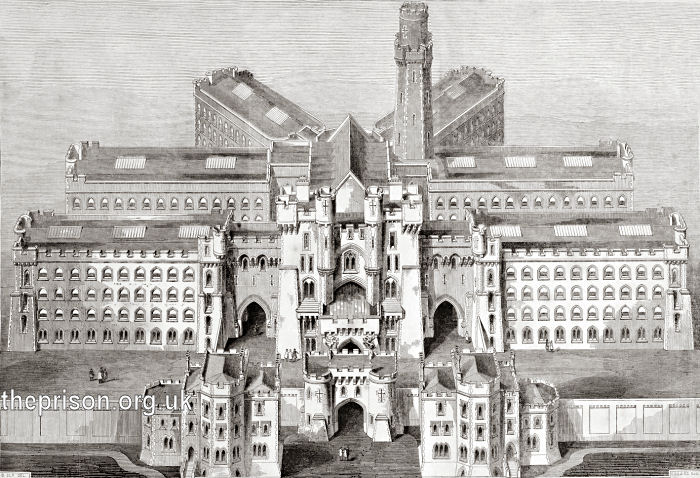
Holloway Prison design, London, c.1848.
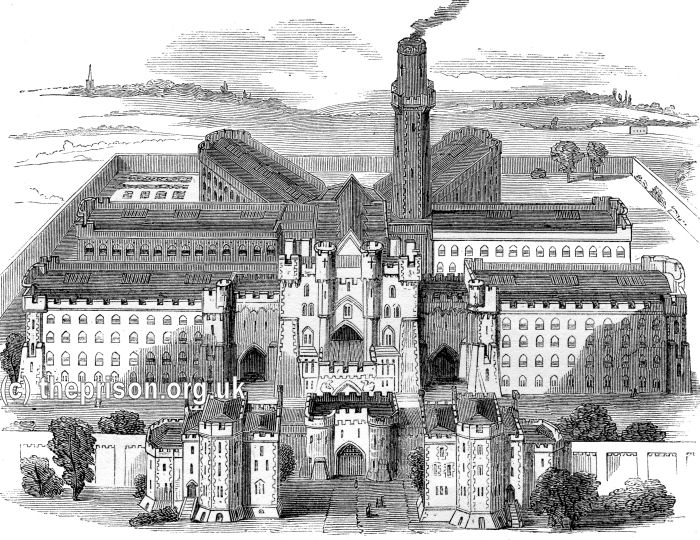
Holloway Prison, London, c.1862. © Peter Higginbotham
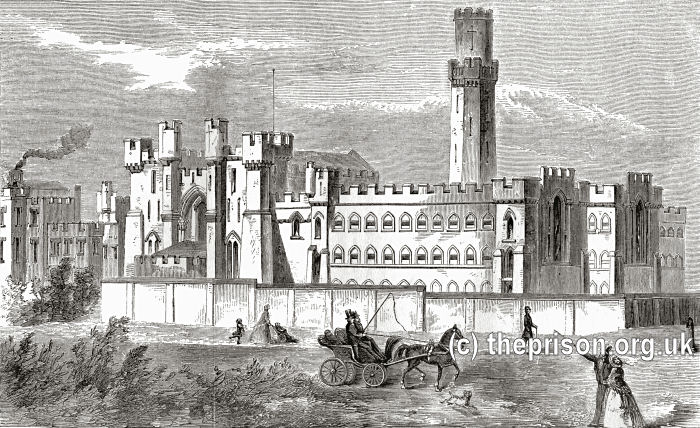
Holloway Prison, London, c.1862. © Peter Higginbotham
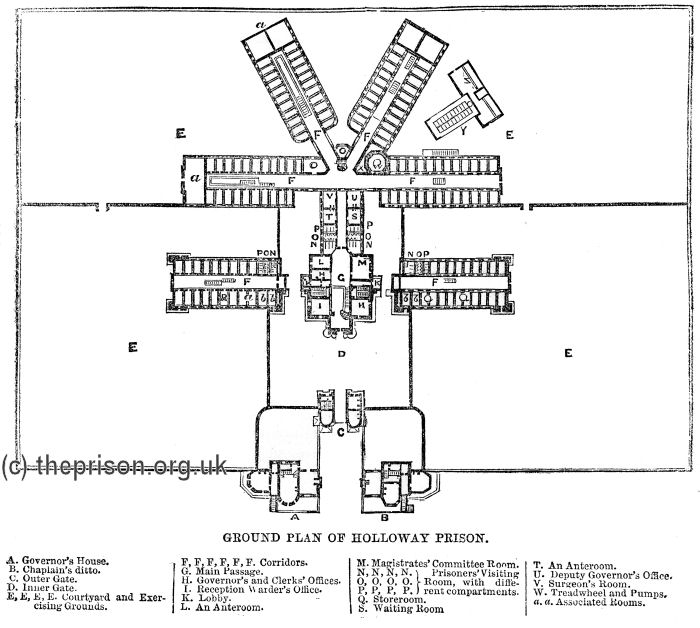
Holloway Prison layout, London, c.1862. © Peter Higginbotham
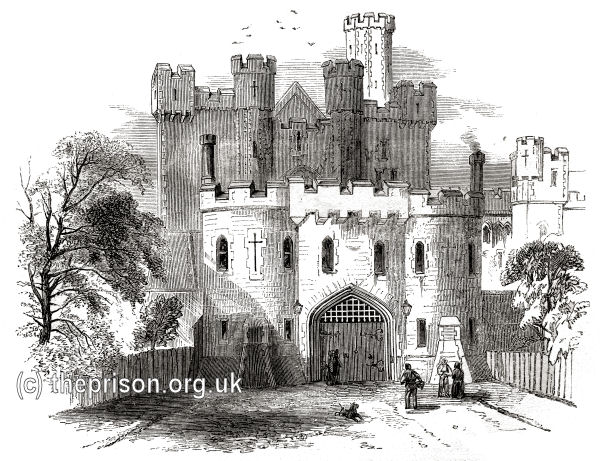
Holloway Prison outer gateway, London, c.1862. © Peter Higginbotham
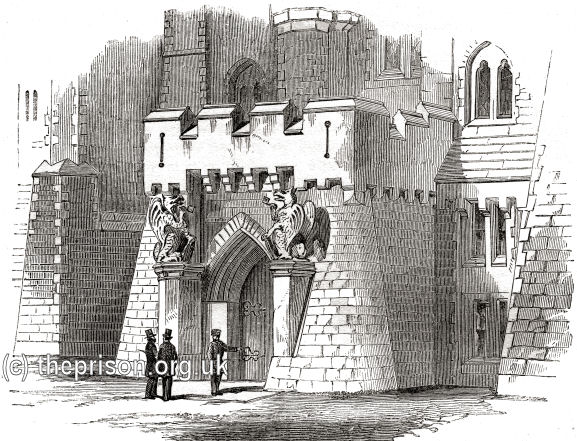
Holloway Prison inner gateway, London, c.1862. © Peter Higginbotham
A lengthy description of a visit to the prison was provided by Mayhew & Binney in 1862. An abridged version is given below:
The Interior of Holloway Prison
As we approached the outer gate of the prison by the enclosed entry flanked on our right hand by the chaplain's house, and on our left by that of the governor, both uniform in appearance and of elegant construction, the battlements and lofty tower of the prison rose conspicuously before us. On our knocking at the outer iron bolted gate, an elderly modest-looking officer appeared at the grating, and admitted us within the walls of the prison. He was attired in the prison uniform, consisting of a surtout and trousers of dark blue cloth and cap with peak, with a dark shining leathern belt, from which was suspended an iron chain with the keys of the prison attached.
We were ushered into the presence of the governor, who, on our presenting our order from the visiting magistrates, introduced us to Mr. Clark, chief warder, to conduct us through the interior of the prison. The latter had a gold-lace band round his cap, and his uniform handsomely embroidered with lace to distinguish him from the other officers.
The Outer Gate and Courtyard
We first inspected the lodge occupied by the gate warder, consisting of a small room on each side of the gateway.
The chief warder called our attention to a book deposited on a desk, where the visitors to the prison are required to sign their names, and requested us to enter our name in it.
The desk contained a visiting-book for the prisoners' friends; also a book for visitors who have received orders from the magistrates to visit the prisoners; another for solicitors who visit the prison;, and a fourth records the attendance of ladies who aid female prisoners on their liberation, by getting them into institutions or providing them with situations in the metropolis.
The gate warder handed us several other books; and added, "There is a book to record the visits of the chaplain and surgeon to the prison; also a book to note the labourers and tradesmen employed within the establishment." He farther showed us a volume in which the vehicles entering the prison gate are recorded, with the numbers of the cabs, carriages, etc.; and the non-resident officers attendance book, specifying the precise time they are occupied in duty; and one containing the names of the male and female prisoners, alphabetically arranged, with the date of their discharge.
Leaving the porter's lodge we enter the pointed arch, which is thirteen feet in breadth, and twenty-nine in length, and at the upper extremity sixteen feet high. The chief warder called our attention to the outer folding-gate of the prison, about eleven feet square. It is composed of solid oak four inches thick, riveted with strong bolts of iron, with a small iron grating about eight inches square, occasionally closed with a wooden trap.
There is also a narrow wicket gate in one of the folds of the large gate for the ingress and egress of the visitors, which is fastened, as in the case of the large gate, with a patent lock. The top of the arch over the prison gate is fenced with strong massive iron bars. The chief warder has a suite of apartments over the porter's lodge; consisting of a kitchen, pantry, parlour, two bed-rooms, with scullery, sink, and water-closet attached.
Leaving the porter's lodge we enter the courtyard, where the prison has a very imposing appearance, with its castellated front, and the lofty wide extended range of buildings forming the female wing on our right, and the juvenile wing on our left hand, each consisting of three floors.
Office, cells, etc. of the Reception-ward
We were admitted by the inner warder into the main prison. On entering by the wicket-gate, similar to the one in the outer lodge, we found ourselves in a spacious hall, beneath the glazed roof of the porch.
The reception ward is situated on the basement; and an ample stone staircase, on the right hand of the reception ward, leads to the central hall and the corridors of the adult prison. The hall is about forty-eight feet in length and twenty-one in breadth, with cocoa-nut matting, leading to the reception warder's office on the left hand, and to the reception cells in front.
We accompanied the reception warder into his office. "Here," said the reception warder, opening a large book, "is the register in which we enter the descriptions of the male prisoners, and there is a similar one for female prisoners. There is another book, termed the clothing and trinket book, in which a record is kept of the various articles belonging to the prisoners."
Pointing to standard measures, which stood near to the window, "There," said the warder, "we take the height of the various prisoners, and also their weight."
The office of the reception warder is floored with wood, and arched with brick, supported by iron girders. The walls are painted of a light colour and tastefully pencilled to resemble large carefully hewn blocks of stone, as in the outer walls of the reception ward. There are two bells here; one of them communicating with the front gate, and the other with the reception or inner gate. The windows are secured, on the exterior, with strong iron bars.
We then proceeded along the hall of the reception ward. At the farther extremity, before we reached the cells, we observed a narrow metal grating extending across from the one side of the floor to the other, which contained hot-air pipes. "This hot-air flue," said the chief warder, "extends along the centre of the reception ward, and gives warmth to the various cells."
There is a board over the door leading to the reception ward, intimating that "Silence is to be strictly observed" by the prisoners. The reception warder told us that the dark passage on the left led to the juvenile, and that on the right to the female branch of the prison, passing through an archway between them on each side; over which was another communication from the main passage on the floor above. At the farther end of the reception hall there is a tap to draw water for the use of the ward, and a water-closet adjoining.
We entered the apartment containing the prisoners' own clothing, on the right side of the reception ward. There we found a large quantity of prisoners' garments carefully packed in bundles and deposited in racks around the walls, arranged according to their sentences, each of them labelled with the name, register, number, and sentence of each. There is a stove for the airing of the clothes in the centre of the room.
Many of the bundles contained ragged and soiled clothing, with a large proportion of respectable and fashionable garments. "Some bundles," said the warder, "belong to rogues and vagabonds, pickpockets and burglars, others to sailors and soldiers. We have several returned convicts imprisoned for picking pockets, and for receiving stolen property. A good number of the prisoners have been clerks in lawyers' offices, and travellers and warehouse men in commercial houses, brought here for embezzling their masters' property; and some have been in good position in society, and are now under sentence for fraudulent bankruptcy. In addition to these, we have many tradesmen and mechanics for various offences. Some of the prisoners have been convicted for uttering base coin, others for lead-stealing, some for swindling, and many for petty felonies."
"At present," said the reception warder, "a good deal of the prisoners' clothing re quires to be fumigated. I attribute this to the fact that a great mass of people are at present out of employment, and many are driven to the low lodging-houses of the metropolis for shelter. Many of our prisoners are covered with vermin, and in a most deplorable condition. A great number of them have very respectable clothing, which does not require to be fumigated. We generally find the most expert thieves are respectably attired, and cleanly in their persons."
We passed on through a door to the reception cells. The Bathroom of this ward is on our left hand. There are two baths in this room, separated by a wooden partition. They are comfortable and commodious, and are supplied with hot water from a cistern in the furnace room, and with cold water from a tank at the roof of the prison.
Adjoining the bath-room is a small store of prison-made clothing, consisting of dark gray jackets, vests, and trousers, with braces, stocks, and shoes. There is also a large chest-of-drawers containing linen, stockings, flannel-shirts, and drawers, etc. for the use of the prisoners. It is provided with a fireplace to air the garments, and a cocoa-nut matting in the centre of the floor, for the comfort of the prisoners when undressed.
We followed the chief warder into one of the reception cells, which was thirteen feet long and seven feet wide. It is ventilated by a grating over the door, connected with hot-air flues, and also by a trap in the window. The window of the cell is three feet six inches wide, and eighteen inches high.
"The furniture of the cell," said the reception warder, "consists of a small deal table, attached to the right-hand side of the cell," which he folded down, like the leaf of a table; "also a water-closet, fixed into one of the farther corners of the cell, which has a wooden lid, and serves as a seat to the prisoner; a wash-hand basin and a tub for washing the feet." Above the table is a gas-jet, over which the prisoner has no control. The chief warder observed, "It is lit at dusk, and extinguished at nine o'clock at night, when the prisoners retire to rest." A copy of the rules and regulations of the prison, and of the dietary, are suspended in each cell, so that the prisoners may know how to conduct themselves.
On the right-hand corner, beside the door, are three small triangular shelves. The bedding, rolled firmly up and fastened with two leathern straps, is generally laid on the upper one; containing a pair of blankets, a rug, a pair of sheets, a horse-hair mattress, and a pillow, which, at night, are put into a hammock, suspended on two strong iron hooks on each side of the cell.
"On the second shelf," added the governor, who had just entered the cell, "is a plate, together with a tin jug for gruel, a wooden salt-cellar, and a wooden spoon. On the lower shelf are deposited a Bible, prayer-book, and hymn-book; two combs and a brush, a cocoa-nut fibre rubber for polishing the floor, and underneath the lower shelf is a small drawer, containing the materials for cleaning the window of the cell.
"On the right-hand side of the door," continued the governor, "there is a small handle, of easy access to the prisoner, by which he is able to ring at any moment when he requires the attendance of an officer." This handle communicates with a bell outside, which is in hearing of the officer in charge. On the officer coming to the door of the cell he opens this wooden trap, which is about nine inches by seven.
"Above the trap is, you observe," said the governor, "a small circular inspection opening, covered with glass on the exterior and fine wire in the interior, by which the officer can inspect the cell from the outside, without the knowledge of the prisoner. After six o'clock in the evening the officers put on list shoes, so that they are able to patrol the corridors in silence, and the prisoner is not aware when he is visited."
The walls of the reception cells, like those in the corridors above, are whitewashed. There are six altogether, ranged on both sides of the ward. There is a wooden machine in the same ward, to which boys are fastened when whipped, by order of the magistrates. The governor observed to us, "I am happy to record that no prisoner has been flogged in this prison for prison offences for the last ten years, since its opening. None have been punished except those ordered by the magistrates at the police courts."
Mode of Receiving the Prisoners.
Prisoners are always conveyed to the prison in a van, escorted by officers. This is generally done in the afternoon, after the sittings of the police-courts. They are forthwith admitted into the reception ward, where they are received by the governor or the chief warder, who ascertains if the warrants and the prisoners correspond. They are then committed to the custody of the reception warder, and placed in the reception cells, in their own clothing. They are afterwards taken from the cells separately and examined by the reception warder in his office.
A minute description of their person is taken, giving their name, age, height, weight, complexion, colour of hair, the colour of their eyes, whether of stout or slender make, their religion, state of instruction, whether married or single, whether they have any children, and if so, how many, the parish and country where born, the place of their last residence, trade or occupation, the magistrate who committed them, whether from the Central Criminal Court, the Mansion House, or Guildhall, their offence, their sentence, the expiration of their sentence, and other remarks.
In this description of the prisoner, particular notice is taken of the marks on his body, such as if he has wounds, or scars, or ink marks, or is pitted with small-pox, etc.
After having passed this examination, the prisoners are separately removed to their respective cells. They are then taken by the reception warder into the bath and dressing room, where their hair is cut according to sentence. They are here stripped of their own garments. A particular account of each separate article is taken in the clothing and property book, kept for the purpose, where the prisoner sees it carefully entered, and signs his name to attest its being correct. This book is signed by the officer who receives the articles, and by the prisoner on his discharge, when the property received is returned to him.
When clothing taken from the prisoners is found to be unclean, it is placed in a fumigating-stove, and thoroughly cleansed from vermin and infection.
The prisoners are taken from thence into the bath-room, where they are thoroughly cleansed in a warm bath, and then removed into the dressing-room adjoining, where they are supplied with an entire suit of prison clothing. They are afterwards removed to the reception cells, where they remain till the following morning, when they are taken by the reception warder into his office, and the prison rules are read and explained to them.
They are examined by the medical officer in the office of the reception warder, who certifies as to their state of health, and notice is taken of any ailment under which they may be labouring, which is duly entered. The medical officer decides as to their ability to perform the labour enjoined in their sentence.
The prisoners are again placed in the reception cells, where they are carefully visited by the governor in his daily inspection of the prisoners, after which they are removed into the body of the prison, to undergo their sentence. They are then committed to the care of the principal warder in charge at the central hall, when they are again examined by the chief warder, and appointed to their respective cells in the various corridors.
"At the expiry of their sentence," continued the reception warder, "they are placed in the reception cells, where they are stripped of the prison clothing and their own garments are returned to them. They are weighed in the weighing machine, and their weight duly entered, to ascertain if they have gained or lost during their imprisonment."
They are afterwards examined by the governor in the reception office, when their case is carefully considered, and clothing and money given to them, as the case may require. They are sometimes sent to a home in the metropolis, or employment is found for them, and an outfit supplied at the expense of the City.
Stores
We were introduced to Mr. C. A. Keene, the clerk and steward, who wished us to inspect his stores before proceeding to the main prison. He first conducted us to the Clothing Department.
The clothing of the male prisoners consists of jackets, vests, and trowsers, of gray army cloth, and stocks, braces, and caps. The caps are made of blue indigo-dyed worsted, and the stockings of a gray worsted, knitted by the female prisoners. Shirts of red striped calico, flannel shirts and drawers of blue striped serge, are also made by the female prisoners. These are systematically arranged, and neatly tied up in separate bundles of a dozen each. There is also a considerable store of shoes of the same quality, sizes from two to ten. The clothes are from two to seven sizes.
The female clothing consists of a blue gown with a red stripe; petticoats made of linsey woolsey; shifts of red striped calico, the same material as the men's shirts; and neckerchiefs of blue check of a large pattern; the linen caps are similar to those worn in workhouses; the stockings are made of a dark blue indigo-dyed worsted, similar to the male prisoners' caps; the cloaks, furnished with hoods, are made of linsey-woolsey, similar to the petticoats.
The bedding is of two different kinds, for the infirmary and the ordinary cells. The infirmary bedding consists of blue and white check coverlets or counterpanes, such as are used in hospitals in the metropolis; the sheets and pillow-cases are made of blue striped calico; the blankets are of substantial quality, white and clear in appearance, bordered with red stripes. The ordinary bedding for the cells consists of a hammock made of strong canvas, a rug, and a blanket, the latter being similar to that used in the infirmary, with sheets and pillow-case made of a coarse brown material, termed "Forfar sheeting." The bed is made of canvas stuffed with coir fibre.
Leaving this storeroom, we were shown into the Hardware Store, consisting of two divisions. One of these contains a large number of iron bedsteads that were removed from the old prison at Giltspur Street, in the City (the Compter), to be used in Holloway Prison when necessary. There are several old chests of drawers, and sundry iron fittings, also removed from the old prison, which are brought into use here as occasion may require.
On the left hand of the stair there are racks in which large quantities of brown leather are deposited for the manufacture of boots and shoes, with a considerable stock of brushes of various kinds carefully arranged. The scrubbing-brushes and cell-brushes are made by the prisoners.
There is a large pile of bars of soap to be used in the laundry, and in cleaning the prison, and large wicker baskets lined with tin, for the purpose of carrying away the dust and rubbish from the corridors and offices of the prison. Along the walls are placed bread baskets, clothes-baskets, and other articles made by the prisoners.
We then accompanied him to the Provision Store, situated at the farther end of the kitchen, on the right hand. This apartment contains six large bins of oatmeal, barley, and cocoa. At the end of the storeroom is a rack for the reception of bread when received from the contractor, previously to its being issued to the cook. On the right hand side are four dressers built in a recess, and on one of them are deposited several large blocks of salt. Under the centre arch is a mill for grinding cocoa for the use of the prison. The cocoa, made from the nuts is considered much superior to that generally purchased in the shops. There is here a weighing-machine, used for distributing the provisions daily to the cook, and a puncheon of molasses, for sweetening the cocoa and gruel served out to the prisoners.
In close proximity there are cellars for the reception of potatoes, for the use of the prison. We afterwards went with Mr. Keene to the cook's store. We observed two large trays of bread on one of the dressers — being part of the day's allowance, received from Mr. Keene on the previous evening. On another dresser there was a number of knives, used by the prisoners. In the centre of the storeroom was a large block of ash, where the butcher-meat is chopped by the cook. There is here an iron-bar, to which hooks are attached, on which the meat is suspended.
Central Hall.
We went with the chief warder to the central hall, a semi-circular space about forty feet in length, with four corridors radiating around it. The central hall rises in the form of a lofty dome, surmounted by a glass roof, in the form of a sexagon, set in a massive iron frame, several tons in weight, with a large grating for ventilation. Here we found two principal warders in attendance, in their uniforms, with keys suspended from their dark shining belts, and three gold laced stripes on their right arm.
There are two skylights in the flooring of the central hall, 4 ft. 6 in, wide, by 6 feet long, consisting of very thick glass, supported on iron bars, giving light to the kitchen beneath. There is also a trap with a lifting machine on either side of the hall, between corridors A and B, and corridors C and D, communicating with the kitchen, by which trays of provisions are hoisted up on cradles to the different cells.
In the central hall is a corkscrew metal staircase, leading from the basement to the different galleries, which is surmounted with a dial; and also a large bell which summons the prisoners to their labour, and calls them to chapel.
While we lingered in the central hall with the chief warder, we saw a detachment of prisoners walk in single file through the central hall, with their hands behind their back, giving a military salute to the chief warder as they passed on from the exercising ground and treadmill to their different cells.
We also saw the schoolmaster moving from cell to cell in one of the galleries, attended by a prisoner, who carried a basket of library books, to be deposited for the use of the prisoners.
We inspected several of the corridors, which are about 133 feet in length from the central hall, and are lighted from the roof by two large skylights, which have openings at the sides for ventilation. A and B wings in addition to those are lighted by large windows at the extremities, provided with fluted glass. At dusk, each of the corridors is lighted with gas.
There is a staircase at the extremity of corridors B and C, leading to the galleries above; with one nearer to the centre in A and D wings. There is also a staircase leading to the basement of each.
Cells
We entered one of the adjoining cells, which is 7 feet wide, and 13 feet long at the top, and 9 feet at the bottom of the arch. It is floored with asphalte, and kept carefully polished and whitewashed. The furniture, consists of a small folding table, attached to one of the sides of the cell, a copper basin, and water-closet, and a water tap covered, resembling those in Wandsworth Prison, with pipes inside, communicating with the water-closet and wash-basin, a soap-box, with soap, a nail brush, and small piece of flannel for cleansing.
In a corner beside the door is a small triangular cupboard with three shelves, on the top of which is the hammock rolled up, and bound firmly together by two strong leather straps. The furniture here is exactly the same as in the cells in the reception ward, except that here there are several library books for the use of the prisoners. In the cell we entered, we saw two or three volumes — one of them titled "Summer in the Antarctic Regions," and another containing the "Narrative of the Loss of the 'Amazon,'" and "Life in New Zealand."
There is a hot-air flue over the door. At the opposite side of the cell, nearly on a level with the asphalte flooring, there is an extraction flue; while under the window is a ventilator, admitting pure air at the pleasure of the prisoner. The deputy-governor opened the ventilator, when a current of fresh air was admitted into the cell.
On the wall is suspended a 'card, containing the prisoner's registered number, his age, etc., as already referred to; and alongside is a copy of the prison regulations as to the disposal of his time, from 5:45 A.M., to 9 P.M., specifying how he is to be occupied in his cell, as well as out of it, in chapel, at school, on the exercise ground, etc.
Corridor A is divided into four wards. Nos. 1, 2, 3, consist of felons guilty of their first offence, and No. 4 of parties tried summarily.
Mat-rooms
We were introduced by the chief warder to Mr. Davies, an active and most intelligent man, who holds the office of mat and rug instructor. He is not an officer of the prison, but is employed by contractors over this large department of prison labour. We entered a mat room, where twenty-two prisoners were engaged at their looms, weaving different descriptions of mats and rugs. This apartment is spacious and well lighted, with a lofty roof, about 27 feet high. It is ventilated by flues on each side, connected with the main shaft. There is a staircase on the left, leading to a mat-room above of a similar size, about the dimensions of twelve ordinary cells. The prisoners were of various ages, varying from twenty to forty-five. We observed an elderly man of sixty years of age, of superior appearance, employed in winding coloured worsted for the use of the looms, while a younger man beside him was working at a spindle; several of them had their jackets off as they plied the shuttle on the loom.
The trade instructor called our attention to another description of mat-making from cocoa nut fibre, of a heavier description, used in halls, at front doors, and in private houses and public offices.
The floor was littered with mats newly cut from the looms, with bundles of coir, termed "dolls," and with coloured fibre, the latter being used in introducing the initials of the names of parties by whom the mats were ordered.
Mr. Davies informed us, that the mats and rugs, of various kinds, made in Holloway Prison, are contracted for by his employers. "I believe," he added, "that they have done so for the past seven years; and this work is executed under my supervision. The discipline is maintained by the presence of a warder in each mat-room. The cheapest description of mats we make here are of a common description, used for ordinary household purposes, as well as for carriages, chaises, dog-carts, etc. They are made with red, green, and blue borders.
"The next quality consists of a superior description of mats, with fancy borders. These are more coloured, and fetch a better price in the market. They are much superior in quality to the others just alluded to, and are chiefly used among the higher circles — the price being commensurate with their quality. This comprises the two kinds of rug-mats. Some door-mats are made with a fibre face, without the aid of colouring. These are used for the interior of houses, and are very durable and remarkably fine in appearance, when well finished."
With reference to the heavier description of cocoa-nut fibre bass-mat, Mr. Davies observed, "These are made from the fibre, spun into strands of a moderate size. They are used for doors of public offices, and occasionally in private houses, and are in almost universal demand. Mr. Davies showed us some mats made for the South Western Railway Company, with the initials of the company inscribed in the body of the mats.
There is another description of mat made in the prison, which has a fancy border, with various devices. They are extremely strong, as well as elegant in appearance.
We were next shown a large stock of hearth-rugs, many of them very beautiful in design, after choice patterns, and the various colours being carefully blended in unison, produced a most harmonious effect.
"The prisoners commence their operations in the mat-room at the ordinary description of mat-making, and are generally about a month in becoming proficient in making common mats. Some have a quicker aptitude than others.
The prisoners work seven hours a-day, beginning their labour at seven in the morning, and finishing at a quarter to seven o'clock in the evening. They are occupied several hours in the interval at their meals, at chapel and school, and in the exercising ground. Many of the prisoners learn mat-making in the prison, and are able to earn a livelihood on their being discharged.
Leaving the upper mat-room we found ourselves in the first gallery of Corridor A. The chief warder called our attention to several gongs in the centre of the galleries which are connected with the prisoners' cells as already mentioned; and to a slate suspended beside each ward on which are entered the prisoners' diet and labour.
Before leaving Corridor A, we went into several of the cells, where prisoners are confined for their first offence. We found an old man seated in a corner of his cell, with a quantity of junk lying by his side. He had a disabled hand, and was not able to separate the strands of the rope which looked as hard as a carved bar of oak. The chief warder kindly showed him the mode of untwisting the rope which was to be teased into oakum. The old man was sentenced to fourteen days' imprisonment with hard labour, but was exempted, the surgeon having certified his unfitness for it; which was signified by the red cross on one of the arms of his jacket.
After inspecting the cells and associated rooms of Corridor A, we went with the chief warder to Corridor B. At the extremity of Corridor B are two large, airy rooms, about 24 feet square, and upwards of 20 feet high. One of them is occupied as a school-room for the adult males, and the other as an associated room for tailors and shoemakers.
Schools of the Male Prison.
We entered the adult school-room, which is an airy, well-lighted apartment, situated on the second gallery. There is a table in the room, beside which the teacher is seated, and several forms are ranged in front and on each side; the seats being raised toward the back.
There is also a black board beside the table in front of the seats. On the left hand, near the fireplace, is a book-case containing library books, maps, music books, etc., and on the walls are suspended maps of the British Empire, Palestine, and the World, with plates of the Theory of the Seasons and the Holy Tabernacle.
The class was not assembled at the time of our visit.
We accompanied the reception warder to the juvenile school-room, at the juvenile wing of the prison, and found Mr. Barre, the teacher, busy with a class of boys, who were reading their primers. The lessons consisted of monosyllables, such as "They walk by faith and not by sight;" "Their steps are known of the Lord, and he has joy in their way." The teacher was seated in his uniform by a table, with a class of half a dozen boys ranged on a form before him. Some were writing on their slates, while others were reading. Sometimes they read together, and at other times one boy read by himself.
On the mantel-piece was a black board, and a map of England and Wales was suspended on the wall. The boys apparently belonged to the lowest order of society. Some of them appeared to be very intelligent, and were very attentive. After hearing them read for some time, the teacher exercised them in simple questions of mental arithmetic, which aroused their attention considerably. A fair-haired Irish boy showed little interest in his reading, but his face beamed with pleasure, and his eye sparkled while his teacher proposed to the class repeated questions such as the following: - "Suppose a man to be 64 years old, and to have a son 25 years of age, how much older is the father than the son?" And, again, "What is the value of 24 pence?"
The teacher told his pupils there was work in London for the steady and industrious.
Mr. Barre informed us:— "I teach four classes daily, which consist of boys and adults. There are two classes of adults in the morning, and two consisting of juveniles in the afternoon. The first class of adults are those who are learning their letters and monosyllables. They are also exercised in mental arithmetic, and are taught to write letters on their slates; none of them write in copy-books. There are, on an average, 20 persons attending this class; their age averaging from 18 to 30, some of them as old as 60. A considerable number do not know the letters, and in the majority of cases these belong to the ordinary felon class. As a rule, the pupils are very obtuse in learning, particularly when they exceed the age of 25.
"I find," said Mr. Barre, "the best means of stimulating them to think is by simple questions in mental arithmetic and other questions of a general character. By this means, numbers get very interested in the class. When I succeed in getting their attention, they make satisfactory progress; in some cases they make great proficiency. As a rule, I find that in these cases they seldom come back to the prison. It has often gratified me when I found the trouble I had taken with them was not thrown away. Those prisoners who have learned to read and write are full of gratitude.
"The class I have referred to meets three times a-week, and the pupils have also work to do in their cells in writing and cyphering. When I see them bring their slates well filled and done satisfactorily, I frequently go to them privately in their cells, and urge them on, and congratulate them upon their progress.
"The second adult class consists of pupils further advanced in their education; some of whom have been transferred from the lower class. Their instruction consists of reading, writing, arithmetic, the elements of geography, and subjects of a general character. "I can always tell," continued Mr. Barre, "when they are interested, and if I see their attention flag on one subject I immediately change to another.
"I have about 20 adults attending this class, which meets three times a week, their age averaging from 16 to 30. The younger prisoners are generally the most proficient. The minds of the young are keener and more elastic than those of more advanced years, and more susceptible of retaining their acquirements.
"I have other two classes of adults whose education consists of a more advanced knowledge of geography, the outlines of history, and some of the higher rules of arithmetic as far as Practice and Vulgar and Decimal Fractions. These classes meet twice a-week, and are attended by 45 prisoners, their ages averaging from 16 to 30.
"We have also a singing class held on Friday afternoon, for practice in Psalmody and the Outlines of Hullah's System of Music, in which the prisoners take great delight. I learn them tunes and anthems for the chapel. This class is attended by about 40 persons, generally of the best educated, and the best behaved men in the prison.
"There are two juvenile classes, consisting of boys from 8 to 16 years of age, The branches of education taught are, in a good measure, similar to those in the adult classes. One of them consists of boys who do not know their letters, or are learning monosyllables. A large number of the boys in the juvenile prison are of this order. They are taught reading, writing on the slate, and the elements of general knowledge, such as the outlines of the History of England, and the elementary principles of arithmetic, by questions and answers. This class is instructed every day in the juvenile wing.
"There is a higher juvenile class consisting of boys who are able to read tolerably. They are taught reading, writing, and arithmetic, and the outlines of general subjects. Many of these pupils are considerably advanced in their acquirements before they leave prison, when their sentence is of any duration.
Tailors' and Shoemakers' Room.
We went into the associated room adjoining the adult schoolroom, in corridor B, where a number of the felon tailors and shoemakers are employed. It was occupied by eleven shoemakers and fifteen tailors. The tailors were seated cross-legged on a large board, in an elevated position, on one side of the room, with gas fittings in the centre, and the shoemakers were ranged in rows on the other side.
The tailors were employed making different articles of dress, such as coats, vests, trousers, etc., for the children of the Emmanuel Hospital, and dark gray clothing for prison use. Mr. Taylor, the warder in attendance, informed us, that "We make here, all the prison clothing for the male juveniles and adults, the uniforms for the officers of the prison, as well as of Newgate, and for the officers at the Guildhall and the Mansion House. In addition to this, we make clothing for the boys of the Emmanuel Hospital, Westminster, numbering about thirty. We also do slop-work for different mercantile firms in the Metropolis, consisting of jackets, vests, trousers, and over coats, and execute the necessary repairs on the prison clothing.
"There are some of the prisoners here," said Mr. Taylor, "who have never used the needle until they came into the prison. After being with us for about six months, they are able to make vests and trousers, and assist in making coats. These could scarcely get a livelihood by their work out of doors; but others, who have been here for about eighteen months, are capable of making a comfortable livelihood.
Each prisoner is expected to make one pair of trousers a day, and very few of them make more than this. They are engaged at work about eight hours a day, exclusive of the time spent in chapel, at school, and on the exercising ground.
The shoemakers were sitting by their stalls, some of them making boots and shoes, and others were busy repairing the prison shoes. One man was engaged hammering a welt, another was scraping the heel of a boot with a knife. A young, fair-complexioned lad, appeared to be absorbed in closing an upper leather; a middle-aged, pale-faced man, with a very flat chest, was busy sewing the welt of a female boot. The boot was fastened on his knee by a leathern strap, held tight by his left foot.
"Most of the young men here," remarked the warder to us, "have learned what they know of shoemaking with me. We make all the shoes worn in the prison by males, as well as females, and likewise for the officers of the prison, and the pupils of the Emmanuel Hospital, and execute the necessary repairs. These fully engage all our hands. I generally get the new beginners to work at closing the uppers, which is a very simple process. From closing the uppers they advance to sewing the bottoms to the uppers, and are very soon able to finish an ordinary shoe.
"We make fine work occasionally, such as the officers ' shoes, which are tastefully done." Here the warder showed us a Balmoral boot made for a boy, a very handsome article, the bottoms being of superior work, and also the stitching of the upper. "The workmen generally finish one boot a-day; some of them do more. We begin our work at seven in the morning in winter, and continue till eight in the evening, with the exception of the hours at chapel, school, meals, and exercise. "Some of the workmen who have been entirely trained with me, will be able to get a decent livelihood at their trade by the time they leave us."
On leaving the associated room by the door which opens into the gallery, we say one of the prisoners laving the face of another with soap, preparatory to being shaved.
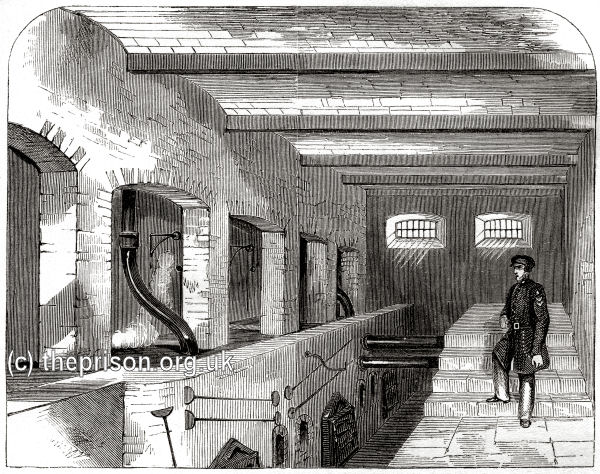
Holloway Prison heating system, London, c.1862. © Peter Higginbotham
Infirmary
We entered the C ward, at the farther extremity, and saw two large rooms, exactly similar in dimensions to those we visited in the B wing, which are here used as an infirmary. We found several prisoners confined by slight indisposition. There is a dispensary adjoining, which is furnished with medicines for the use of the prisoners. It is under the immediate care of a warder, and has the appearance of a druggist's shop with the phials carefully labelled and arranged on shelves erected around the walls. One of those large rooms made use of for infirmary purposes was empty. It is furnished with a table in the centre, and a form on either side, with a copious supply of bedsteads and chairs. It is well ventilated by flues, and one of the large windows can be drawn down from the top to admit a current of fresh air. There is a comfortable fireplace in the room.
We proceeded to the other room with the infirmary warder. There we found nine beds in the apartment. There was only one patient in bed, an old man, who was suffering from rheumatism. There were six other invalids in the room afflicted with rheumatism and cold, while a seventh acted as nurse. There happened to be no serious case of illness at the time of our visit. Some were reading by the comfortable fire, or seated on the bedsteads. The bedding consisted of a straw palliasse, a blue striped mattress stuffed with wool, a pair of blankets, a pair of sheets, a pillow containing horse-hair, and a blue striped coverlet of a neat appearance. At the side of each bed there is a portable cupboard where the prisoners can deposit their utensils and food. There are also several shelves in the room, which is lighted by gas jets.
A pale-faced young man sat on a seat by the fire in apparently a very infirm condition, suffering from a pulmonary complaint. He breathed with great difficulty, his breast hearing convulsively at each respiration. Another smart young man was confined, who was occasionally subject to fits.
Chapel
The chapel is a large and elegant building, fitted to accommodate the whole of the prisoners at one service. It is much larger than the one at Wandsworth. The adults are ranged in two divisions along the far extending galleries in front. The juveniles meet in an inclosure on the left hand, and the females in another on the right, and are not seen by each other. The chaplain occupies a pulpit in the centre of a pew, erected adjoining the wall, in front of the adults, about the same height as in other chapels. The governor and his family sit on the right hand, and the chaplain's family on the left. There is besides accommodation for the chief warder, and any of the magistrates or other visitors. On the wall, beneath the pulpit, is tastefully inscribed a copy of the Lord's Prayer, the Ten Commandments, and the Apostles' Creed. Underneath this is the Communion table fenced within an oaken railing, raised two steps above the level of the floor.
A lofty strong iron railing separates the adults in the gallery from the area below. The lower part of the gallery is divided by a low wooden railing, with a stair on each side leading to the second landing, and extending upwards on each side of this passage to an entry on the third landing above, which is on a level with the highest galleries in the corridors. The interior of the chapel is lighted at dusk with a circlet of gas lights suspended from the lofty roof as well as by a series of gas jets on each side of the galleries.
So soon as the bell rang, we entered the chapel along with the governor, and sat in the elevated pew before referred to, entered by a door from behind, and had a commanding view of the adults ranged along in the ample galleries, attired in their dark prison dress. a more cheerful scene than the chapel service at Wandsworth and Pentonville, where the heads of the prisoners could only be seen occasionally peering over the iron clasped boxes in which they were confined. Most of the adults were from eighteen to thirty years of age, yet we noticed several bald-headed men amongst them, some of them with a very respectable appearance. One elderly gentleman in particular, imprisoned for fraudulent bankruptcy, had a superior air to the mass of the felons around him. We could single out a few good-looking young men, clerks and others, with an engaging manner. The mass of the prisoners belong to the ordinary felon class of the metropolis; some with a dull dark beetling brow, and others with a sharp clear aspect, indicating a more acute and lively mind. Many of them we conjectured, from their arched eyebrows and peculiar features, were of Hibernian extraction. Two warders, with their backs to each other, were stationed in the centre of the gallery. One of the principal warders sat at the back of the gallery facing the chaplain, Many of the female prisoners were of a degraded appearance, though we could single out a number of good-looking felons among them, some of them very expert shoplifters and pickpockets.
The religious services were listened to with the greatest propriety. Many showed a devout frame of mind in the devotional exercises, and apparently joined with great fervour in the Psalmody, which was most decorously conducted. The chaplain delivered an admirable discourse, which was listened to with marked attention.
At the close of the services, the governor informed us that fifteen of the adults had not read their books during worship, and remarked that thirty-five of the seventy females present, were unable to read.
In answer to our inquiries regarding the chapel service, the reception warder gave us the following information:— "At a quarter-past eight o'clock the principal warder in charge rings the bell for the prisoners to proceed to the chapel. The warders then unlock the cells in the various corridors. The prisoners pass in files along the galleries, about three yards apart from each other. At the chapel door, a principal warder and an ordinary warder, count the prisoners of each corridor passing into the chapel, as a check on the number of prisoners in the reception wards. They enter the chapel from the second and third landings adjoining the central hall, and after service are again conducted back to their cells in a similar manner."
We were introduced by the governor to the chaplain, when we learned that prisoners of all sects of religion attend the chapel with the exception of one Roman Catholic, a very Eccentric. All controversial subjects are excluded from the services.
Every morning, immediately on leaving chapel, those prisoners who were admitted into the prison on the previous day, are brought before the chaplain, who takes a note of their register number, and the number of their cell, whether married or not, number of children, the parish and county to which they belong, their trade or occupation, whether in work or not, their previous commitments, their offence, the cause of their offence, their sentence, the date of their discharge, their education and religious training, and whether they have attended Divine worship during the last six months.
The chaplain generally gives them something to learn, such as Scripture texts, suitable to their position and state of mind, which they commit to memory, and repeat to him about a fortnight or a month after. When they are in difficulty as to the meaning of any passage of Scripture in their Bible readings in the cells, they are urged to come to him for an explanation immediately after service.
The prisoners are all very fond of the singing-class which assembles every Friday to practise the psalms and hymns for the Sunday. Occasionally the chaplain's wife, with the help of the school master and the harmonium, teaches them a new tune, which seems to give them much pleasure. Many a prisoner who is unimpressed by anything else, is moved to tears while singing a hymn. There are many educated men amongst the prisoners, but the chaplain has not had one educated female under his charge. There are eight lady visitors, who meet the chaplain every Thursday in the committee-room. After engaging in prayer, they call on the female prisoners in their various cells. Those who wish to reform have the offer of admission into a reformatory.
The Tread-wheel
We visited the tread-wheel, which is worked to pump water for the whole prison, and situated between the C and D wings. The apartment in which it is contained is about 24 feet 6 inches in breadth, and 54 feet 6 inches in length, having a small inclosure penned off opposite the wheel, containing machinery, connecting the wheel with the pumps, which are adjoining. The tread-wheel consists of two divisions or compartments, the larger one being intended for the adults, and the smaller for juveniles. There are sixteen boxes in the larger compartment and eight in the other.
In front of the wheel there are eighteen inclosed seats erected alongside of each other in the larger compartment, where the prisoners are engaged in picking oakum in the intervals of labour. There are ten boxes in the smaller compartments where the juveniles work; two of them being generally occupied by the prisoners engaged on the handles of the pumps in the inclosure already referred to.
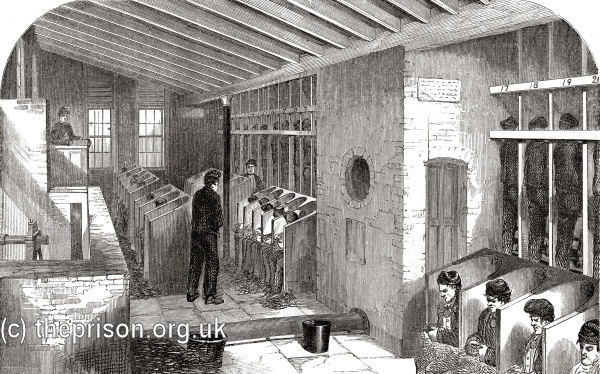
Holloway Prison tread-wheel and oakum shed, London, c.1862. © Peter Higginbotham
There are two warders in charge of the tread-wheel, one on the one side, and another on the other; all of which arrangements have been admirably sketched in an engraving given in a former part of the work.
Between these two divisions, and on the right hand side as we enter, there is an inclosed space, in which a portion of the machinery is situated, and a well has been sunk to the depth of 370 feet, from which the water is pumped by the treadmill, and conveyed to large tanks on the top of the building, from which the whole of the prison is supplied.
At the time of our visit there were ten prisoners engaged in the larger division of the wheel and eight on the smaller, and two of them were bending and straining at the pump handles. As the wheel turned steadily round, each man took an upward step, keeping time with the velocity of the wheel. Some had stripped off their jackets to work with greater freedom; several were toiling lazily at the work, and others were active and elastic, particularly some of the younger lads, who took it remarkably easy. Most of them were young men, varying from sixteen to thirty-five years of age, many of them being short and active, and evidently felons of the metropolis. One or two of them appeared to be clerks or shop men, from their superior look and manner even in the prison dress. One man, advanced in life, sat on one of the seats near us, with a heavy, stupid countenance; many of the others had the keen sharp eye and roguish look, characteristic of many of our London felons.
Those sitting in the seats in front were busy picking oakum, in the interval of tread-wheel labour, as they were occasionally relieved from the wheel, and others took their places. They did not appear to be so fatigued with the hard labour as we expected — not nearly so much as those toiling at the hand-mills in the separate cells in Wandsworth prison. One of the prisoners, a young man who had been slightly indisposed, was offered some medicine by one of the warders, but refused to take it, and was chided for his disobedience by the reception warder who accompanied us.
There is a bell attached to the wheel, which rings every two minutes and a half, marking a certain number of revolutions. At certain intervals, three prisoners come down from the wheel, and other three leave the seats in the area, and take their places.
Each man, on going to the wheel, steps up on a form in front, and thence plants one foot on the wheel, at the same time laying hold with his hand on an iron handle to keep himself in an upright position. In the event of his not keeping pace with the wheel, he is brought down, and liable to be injured. From the motive of self-preservation, he is compelled to keep pace with it. At the top of each box or inclosure there is a ventilator for the admission of fresh air, and it is numbered in the inside, by which number the prisoner is called when there is occasion. There is a corresponding number on the outside, for the use of the officer on duty.
At the extremity of the shed on the left hand, there is a water-closet, and upon the walls on either side is a notice that silence is to be strictly observed. The building is well lighted and ventilated.
Each prisoner remains on the wheel for twenty minutes at a time, and alternately picks oakum in the seats in front for other twenty minutes. The wheel is five feet in diameter, and makes three revolutions in two minutes and a half.
The tread-wheel labour generally lasts from seven o'clock in the morning till four o'clock in the afternoon, with the exception of the hours spent in chapel, at meals, etc. The prisoners are employed on the wheel on an average of four hours and a half per day. The labour is not very oppressive to a considerable number of them. Some, however, appear to be very fatigued at the close of the day. We observed a long file of prisoners from the tread-mill passing through one of the corridors on their way to their cells, who were, apparently, in no way exhausted with their day's task.
The average amount of distance travelled by the prisoners on the wheel is about 6500 feet in winter, and about 8700 feet in summer - much below the maximum height allowed by law, which is 11,000 feet. When sufficient water is obtained the prisoners are taken off and placed at more remunerative labour.
Adjoining the treadwheel and attached to it is a shed covered with zinc, containing twenty-two separate stalls, with a pump-handle in each, to give additional assistance to the wheel if necessary, as both can be employed to pump water for the use of the prison.
Exercising Grounds
There are five exercising grounds attached to Holloway Prison — one close to the female wing on one side of the courtyard leading into the prison, and another to the juvenile wing on the opposite side, and three at the back of the main prison, one of them near the end of B wing, another near to the C wing, and a third between the B and C wings, as seen in the bird's-eye view of the prison. Leaving the tread-wheel, we visited the adult exercising grounds. The prisoners were then actively engaged in exercise in the various concentric circles, all within sight of each other, attended by several warders, and under the inspection of one of the principal warders.
The spaces between the two extreme exercising concentric circles were planted with kitchen vegetables, while the central one was a hard beaten portion of ground between the B and C wings, which had not been planted, but is used as a drying ground. There are four iron posts in the latter, to which drying lines are attached, with a lamp in the centre lighted with gas at dusk.
The day of our visit was bitterly cold, and the prisoners were walking smartly along to keep themselves in heat, particularly in the central ground, where they hurried round in double quick time. Many of them were pale and shivering from the keen biting air; others were of a bluish tint, and some of their cheeks were of a dull red. They generally kept about three yards apart from each other. The generality of them were of the ordinary felon stock In the prison-dress it would, in many cases, be difficult to distinguish the casual from the habitual offender. There was less military precision in their movements on this occasion than in the case of the gloomy masked men at Wandsworth and Pentonville, but this we believe, was owing to the inclemency of the weather.
There is a carriage-drive around the back of the prison. The surrounding grounds are planted with kitchen vegetables of various descriptions, for the use of the prisoners, and with a large quantity of mangold-wurzel, which is sold to dairies.
There is a pavement extending around the exterior of the wings, about six feet in breadth, close to the prison.
While we stood in the garden along with the reception warder, overlooking this lively scene, we saw another gang of prisoners taken out to replace this detachment which was removed to the different corridors.
The adult exercising grounds are fenced by a lofty wall stretching across from the extremity of the D wing to the boundary wall separating it from the grounds attached to the female wing, and from the extremity of the A wing to the opposite boundary wall, dividing it from the garden attached to the juvenile prison. The exercising circles are overlooked by the range of houses on the left hand.
We were conducted into the garden attached to the female prison, where we found the warder in charge, perched on a ladder placed against the wall, overlooking five of the prisoners, mostly young lads, engaged in removing earth from a mound to fill up a cesspool at the corner of the garden. On being introduced to him, he stated, "It is my duty to super. intend the gardening operations. At present I have twelve men assisting me over the grounds. In general I have from ten to twenty. We sow and plant a large quantity of potatoes, leeks, cabbage, and other vegetables, for the supply of the prison.
The Kitchen
We visited the kitchen, situated in the basement of D wing, and were introduced to the cook. It was then about mid-day. He was busily engaged preparing dinner, which was about to be served up.
There are six large boilers in the kitchen with copper lids — each of them having a steam pipe communicating with a large boiler in an adjoining recess. One boiler contained a large quantity of broth, with huge pieces of beef. The cook uplifted several of them on a large fork; they appeared to be of excellent quality. They were carried away by one of the prisoners in attendance, to be cut up into small portions to be put into the dining tins, and distributed to the various prisoners in the different cells. We had a small quantity of soup served up to us, which was very wholesome and palatable.
Another boiler contained a large quantity of potatoes which had just been cooked. They were York Regents of an excellent quality.
A different boiler contained an enormous quantity of gruel, made of the best Scotch oatmeal, to be served out for supper in the evening. It was filled to the brim, with a white creamy paste mantling on the surface. Cocoa is given on alternate days, and is prepared in the other coppers we saw alongside.
There are three doors leading through to a large central apartment, which contains a long table on the side next the scullery, used for cutting up the bread and weighing it out, and another table at the extremity on the left hand, used for cutting up the meat on those days when soup is prepared. We observed a large fireplace here used for cooking such articles as are ordered by the surgeon for the use of the infirmary, with an oven attached to it.
We passed on to the scullery, which contains two sinks for the purpose of washing the tins and other dishes. They are supplied with a tap at each end, one supplying hot, and the other cold water. The bread trays are deposited on a table at the side of the room when not in use, and the bright tins are carefully set in rows on a rack on another side. Here we found a prisoner with some broth and mutton, which had been prepared for the use of the infirmary.
We proceeded into the cutting-up room, where we found several prisoners, assistants of the cook, cutting up the meat for dinner, on a large table, while others were engaged in filling the pannikins with potatoes and meat for dinner. Each pannikin is divided into two compartments, one containing potatoes, and the other meat, each pannikin being furnished with a knife.
The cook generally has four assistants in his work. An additional hand is occasionally employed in the kitchen, who helps the engineer in attending to the furnace and other duties.
On the wall is suspended a long dark board for the cook's guidance, with a note of the provisions to be served out to the different wards. It is corrected every morning by one of the principal warders, who gives the necessary instructions.
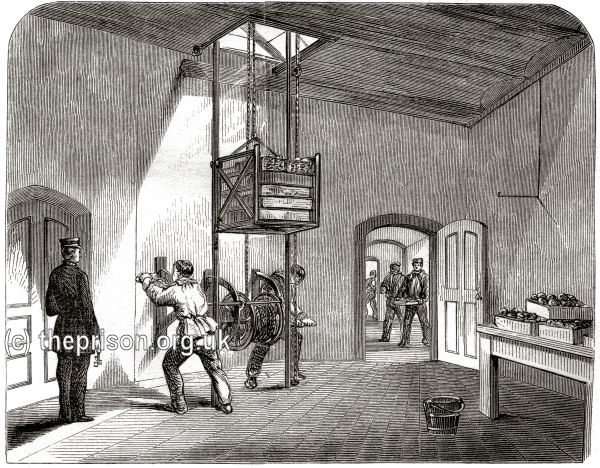
Holloway Prison lifting apparatus for serving dinner, London, c.1862. © Peter Higginbotham
We passed on to a large apartment nearly of a semi-circular form, situated under the central hall. At each end is a windlass for hoisting up provisions to the various corridors, and in the centre is a spiral staircase leading up through the central hall to the galleries of the prison.
We ascended to the central hall, and saw the principal warder in charge superintending the serving up of the dinner. The trays were conveyed along to the extremity of the different galleries on food carriages, similar to the mode pursued in Pentonville and other prisons. This operation was executed with great order and despatch.
In answer to our interrogatories, the cook informed us: — "The fire is generally lit about three o'clock in the morning by one of the night watchmen, when the steam is got up to prepare the gruel or cocoa, served up for breakfast on alternate days.
"I begin my duties," said the cook, "at seven o'clock in the morning, when the gruel and cocoa is served up with bread to the different corridors; sometimes cocoa and bread, at other times gruel and bread. These are the breakfast operations. The butcher in general arrives about ten o'clock, when we prepare for dinner, consisting of meat and potatoes, or soup and potatoes, which are served up at one o'clock to all the branches of the prison. "The gruel for supper is prepared at an early period of the day, generally at dinner-time, and stands in the copper for several hours. By this means it becomes thicker, and its qualities are improved, and besides it economizes our fuel. The bread is cut and weighed out, to be served up with the gruel for the prisoners' supper, which ends the culinary operations of the day."
We were informed there is no baker in the prison. The bread is contracted for by a tradesman in the Metropolis, who supplies the prison every day. It is made of second flour, and we found it to be of excellent quality.
We proceeded to the D wing in company with the chief warder. On visiting the cells we found a number of prisoners engaged picking oakum. As we passed along, we found it was an imperative duty in this prison for the prisoners to shut the doors of their cells, and at the same time for the officer to test their being closed.
We visited the basement of corridor D, where there are eight large commodious baths, similar to those we found in the reception ward. We passed through a door into a passage, where there were several punishment cells, all of them then empty. We learned there are very few punishments inflicted in this prison.
The doors resemble those of ordinary cells: about five feet distant is another door, which deadens the noise created by any refractory prisoner. At present there are six dark cells, but originally there were sixteen. Ten of them have been made into a workshop, "and it is contemplated," said the governor to us, "to convert three of the present number into light cells."
The Juvenile Wing
The Juvenile Wing of the Prison is situated to the left of the reception ward, and is reserved exclusively for young male offenders from seventeen years of age and downwards. On entering the corridor, we were introduced to Mr. White, one of the warders, who stated:— "At present we have nineteen juveniles under seventeen years of age. Our prisoners here are under the same routine of prison discipline as in the other corridors. The boys under fourteen years of age are exempted from hard labour by Act of Parliament. From the nature of their offence, they are sometimes sentenced to it, as, for example, in picking pockets, but with prisoners of those tender years it is not carried into effect. Instead of working at the treadwheel, they are employed picking oakum, or some other occupation.
In the juvenile wing there are three reception cells and a bath-room, with one bath of smaller dimensions than those in the adult reception ward, and also a store of prison clothing for juveniles, carefully arranged, along with a store-room containing the prisoners' own clothing.
There is a staircase leading from the reception ward to a small lobby entering into the corridor. On the right side of it are four small wooden compartments, where the friends and relatives of the juveniles visit them. These are covered over on the top with a wire-screen, similar to what we found in the adult branch of the prison. There is a door in the corridor by which the prisoners are introduced to similar compartments on the other side of the visiting-room, with another door in the centre, where a warder usually patrols during the time of the interview.
There are six refractory cells in this wing of the prison, but at the time of our visit there were no prisoners confined in them. "It rarely happens," said Mr. White, "we have any delinquents in custody." There are few punishments inflicted in this prison, yet the discipline is strictly maintained.
Adjoining these dark cells there is a bath-room, containing two other baths for the use of the juvenile prisoners.
| ORDINARY DISTRIBUTION OF A PRISONER'S TIME. | ||||||
| Summer | Winter | |||||
| from | to | from | to | |||
| 5.45 | — | 6.45 | — | A.M. | Rise; open ventilator, and spread bedding, and wash. | |
| 6.00 | 7.20 | 7.00 | 7.30 | " | Employment. | |
| 7.20 | 8.10 | 7.30 | 8.10 | " | Breakfast, and prepare school lessons, clean cell, and make up bed. | |
| 8.10 | 9.00 | 8.10 | 9.00 | " | Chapel | |
| 9.00 | 12.45 | 9.00 | 12.45 | P.M. | Exercise, employment, school, etc. | |
| 2.00 | 5.45 | 2.00 | 6.45 | " | Employment and school. | |
| 5.45 | 6.30 | 6.45 | 7.30 | " | Supper, and work in cell. | |
| 6.30 | 8.00 | 7.30 | 8.00 | " | Employment in cell. | |
| 8.00 | 8.45 | 8.00 | 8.45 | " | Sweep cell, wash, read or write, and prepare school lessons. | |
| On SUNDAYS. | ||||
| 6.45 | A.M. | Rise. | 2.00 to 3.00 P.M. | Exercise. |
| 8.00 | " | Breakfast. | 3.00 | Chapel. |
| 9.00 | " | Exercise. | 5.30 | Supper |
| 10.45 | " | Chapel. | 8.00 | Bed. |
| 1.00 | P.M. | Dinner. | ||
The Female House of Correction, Holloway
We accompanied the governor to the female prison, which is situated opposite to the juvenile wing, and were introduced to the matron, and entered a small lobby on the ground floor beneath the archway connected with the main prison. On our right hand is a small room neatly furnished for the use of the laundry warder, with a bedroom adjoining. lobby are two bells, one communicating with the door on the exterior, and the other being a night-bell connected with the rooms of the female officers of the prison.
At this time several female prisoners came downstairs from the corridor above, with the shining tins for dinner to be conveyed to the kitchen.
Reception Ward
Leaving the lobby, we descend four stone steps into the reception ward on the basement. The central floor is laid with asphalt, with a narrow stripe of pavement on each side, adjoining the cells.
On the right are the matron's apartments, consisting of a kitchen and bedroom. On the left is a bath-room containing two baths and a sink, also a dressing-room, somewhat similar to those in the adult prison. There are three reception cells in this ward. At the extremity of the reception ward are two dark cells, but no prisoners were confined in them at the time of our visit. They are similar to those in the main prison, and are furnished in a similar manner.
We then passed into the store-room containing the prisoners' own clothing, together with an assortment of prison dress. The prisoners' own clothing was laid in racks along the wall in the interior of the apartment, and the prison garments were assorted on shelves.
The female prison clothing in Holloway Prison consists of three wincey petticoats in winter, and two in summer; a blue gown, a checked apron, a blue checked neckerchief, a small printed pocket handkerchief, and a white linen cap. Likewise a pair of blue worsted stockings, and a thick substantial shawl, both knitted by the female prisoners. The bedding is the same as in the other corridors.
The matron informed us, "There is only a small portion of the bundles of clothes fumigated; belonging chiefly to the lowest class, such as vagrants and prostitutes, many of them of Irish extraction."
We saw a considerable number of bundles of more elegant appearance on the shelves.
The matron stated that, at present there is a larger number of fashionable pickpockets and shoplifters in the female prison than she has ever previously known. "We generally have some showy pickpockets," she added, "but never so large a number. Their ages vary from twenty to thirty-five years of age - seldom above thirty-five.
As we passed along the ward, from the window of the matron's room we saw a large company of the female prisoners in the exercising ground, their heads being covered with their hooded shawls. They moved along with active step, under the charge of a female officer.
Leaving the reception ward, we went to the corridor above, where a very animated scene presented itself to our view. A large number of the female prisoners were exercising around the galleries under the inspection the female chief warder, who was stationed on a bridge across the first gallery, while a female warder was stationed on a bridge in the higher gallery. After exercising for some time they returned to their various cells.
The female warders were attired in a brown dress, with a dark head-dress. The chief warder informed us the first gallery contains the prisoners tried at the Central Criminal Court, convicted of the most heinous offences, and in the second gallery are disorderly prisoners and others tried at the Summary Courts.
On the first day of our visit the prisoners were occupied in the following employments: Picking oakum, 12; at needle-work, 14; in the laundry, 8; engaged in general cleaning, 6; nursing, 2; sick in cells, 2; in infirmary, 4; in reception ward, 3; knitting caps and stockings, 15; in all 66 prisoners.
Laundry
This is a large, well-aired, commodious apartment. At a large table in the centre of the room, several female prisoners were actively engaged in folding up a quantity of female underclothing, while some bundles were piled on the table beside them.
There was another table at the left side of the room, on which a portion of the clothes lay folded, others of the prisoners were busy mangling. There is a large copper at the extremity of the laundry, in which the clothes are boiled. It is supplied with steam by a large cistern above it. There is also a screen in which the linen is laid out to dry.
We noticed several large bundles containing male prisoners' clean clothing ready for use. Adjoining the laundry is a drying-room, furnished with six clothes horses, which can be drawn out and into a recess, where the 'wet clothes are exposed to the action of heated air. Two of the prisoners were ironing white linen.
We observed here a pretty young woman — an expert and fashionable pickpocket. She had a very fine face and figure, and her bright eyes were fringed with long black eyelashes. We learned from the chief warder that she cohabits with a low fellow in the City, and has been frequently in confinement charged with picking pockets. She was handsomely dressed when brought to the prison.
"You see that prisoner," said the chief warder, referring to a plain-looking, middle-aged woman, who was sitting beside the mangle, "she is also an expert pickpocket, and an old offender."
The prisoners employed in the laundry are allowed a pint of beer every day, of which they were partaking at the time we entered.
In the proximity of the laundry are eight washing boxes, supplied with hot and cold water by means of taps, where some of the female prisoners were busy washing. Meantime several male prisoners came in escorted by a warder (while the females had for a short time retired ), and carried off several large bundles of white linen to the male prison.
The female prisoners in the laundry wash the clothing for all the branches of the prison.
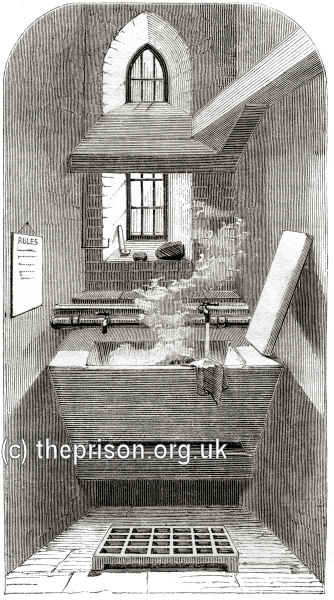
Holloway Prison washing cell, London, c.1862. © Peter Higginbotham
The School
The female classes are convened in a large comfortable apartment at the extremity of the corridor on the first gallery. On the walls are suspended a map of the two hemispheres, and another of England, along with a number of pictorial illustrations of Scripture subjects. A black-board is set on a stand. The teacher, an active intelligent lady, stood in front of the class, which was ranged on a deal form in front of her. There were from twelve to fifteen females present in the adult class at the time we visited them, consisting chiefly of fashionable pickpockets and shop-lifters. Their ages averaged from seventeen to thirty-five. Some of them were good-looking, and apparently modest one or two had a superior air about them. One prisoner in particular, a tall, fair complexioned, handsome woman - a fashionable pickpocket — had a striking and commanding appearance, even in her felon garb. She was brought to the prison in a rich black dress with three flounces, and a handsome cloth cloak, an elegant bonnet beautifully trimmed, and boots with military heels. Her petticoats were also of the best materials. "She was dressed and garnished with jewellery," said the teacher, "like one ladies in the land, and from her appearance and manner no one would have suspected her real character." She resided at Kensington with a worthless character, and hired an old woman to keep her child at the rate of £1 a week." A young woman of about twenty-two years of age, with a fresh, blooming complexion, also a pickpocket, sat by her side; while her eye drooped on her book, her countenance was lit up by a beautiful expression, but on looking up, as she did occasionally, she appeared less interesting. Another young woman, a pick pocket, of about nineteen years, sat beside them, with a very ingenuous appearance. On the matron interrogating her as to the particular nature of her offence, she burst into tears. A good-looking young woman of about twenty-four years of age, who had been detected picking pockets sat opposite to us. She had formerly been a barmaid in the city and had been led astray by bad company. A plain-looking, dissipated woman sat next her, who had led a very wild and romantic career in the Metropolis, as the paramour of a daring burglar. She still cohabits with him, and now picks up a base livelihood by roaming the west end at midnight, and plundering drunken men. Another woman, respectable-looking, of about thirty years of age, who had been guilty of forging a bank cheque, sat at the farther end of the class. Some of them were reading attentively, others with their slates on their knee, and a few knitting stockings.
The teacher was busy when we entered with the reception warder, explaining the three Kingdoms of Nature to the class. We did not remain long on this occasion.
On a subsequent day we visited the class with the matron, which was then engaged with the Bible lesson. Most of the prisoners read very fluently and correctly, and conducted themselves with great propriety of demeanour. They afterwards clustered around the map of England, alongside of their amiable teacher, and appeared to take great interest in their geography lesson.
After the class had been dismissed, and the prisoners had retired to their several cells, the teacher gave us the following information:—
"There are two classes here. One of them is attended by those learning the elements of reading and writing. There are about twelve pupils attending this class, their ages averaging from fifteen to forty. Some of them learn very rapidly, but others are very obtuse. There are several with me at present who have learned to read with tolerable ease in the course of six months, and are able to write a letter to their friends. The younger prisoners are the most proficient scholars. This class is held four times a-week.
"The other class consists of adults, who are taught reading, writing, and arithmetic, geography, and general information. In age they vary from twenty to forty-five. These often make great progress. This class is also held four times a week.
"On Saturday we have a class for the women attending the laundry. The school is generally appreciated by the prisoners.
"There is also a circulating library belonging to the prison. The books are distributed once a-week in the various cells, and oftener if it is considered proper. "Some well educated female prisoners read out of the library who do not attend the classes. There are seldom so many of this superior order in the prison that I could muster a class. They generally avail themselves of the use of the circulating library, and write exercises on their slate in English composition.".
LIST OF THE DIETARY FOR PRISONERS AT HOLLOWAY PRISON.
Approved by the Secretary of State, 24th April, 1850.
| CLASS I. Convicted prisoners confined for any term not exceeding seven days:— | |||||
| MALES. | FEMALES. | ||||
| Breakfast | Oatmeal gruel | 1 pint. | Breakfast | Oatmeal gruel | 1 pint. |
| Dinner | Bread | 1 lb. | Dinner | Bread | 1 lb. |
| Supper | Oatmeal gruel | 1 pint. | Supper | Oatmeal gruel | 1 pint. |
| CLASS II. Convicted prisoners for any term exceeding seven days, and not exceeding twenty one days: | |||||
| MALES. | FEMALES. | ||||
| Breakfast | Oatmeal gruel | 1 pint. | Breakfast | Oatmeal gruel | 1 pint. |
| " | Bread | 6oz. | " | Bread | 6 oz. |
| Dinner | Bread | 12 oz. | Dinner | Bread | 6 oz. |
| Supper | Oatmeal gruel | 1 pint. | Supper | Oatmeal gruel | 1 pint. |
| " | Bread | 6 oz. | " | Bread | 6 oz. |
| Prisoners of this class, employed at hard labour, to have in addition 1 pint of soup per week. | |||||
| CLASS III. Convicted prisoners employed at hard labour, for terms exceeding twenty-one days, but not more than six weeks; and convicted prisoners not employed at hard labour, for terms exceeding twenty-one days, but not more than four months:— | |||||
| MALES. | FEMALES. | ||||
| Breakfast | Oatmeal gruel | 1 pint. | Breakfast | Oatmeal gruel | 1 pint. |
| " | Bread | 6 oz. | " | Bread | 6 oz. |
| Wednesday and Friday. | Wednesday and Friday. | ||||
| Dinner | Soup | 1 pint. | Dinner | Soup | 1 pint. |
| " | Bread | 6 oz. | " | Bread | 6 oz. |
| Tuesday and Sunday. | Tuesday and Sunday. | ||||
| Dinner | Cooked meat, without bone. | 3 oz. | Dinner | Cooked meat, without bone | 3 oz. |
| " | Bread | 8 oz. | " | Bread | 6 oz. |
| " | Potatoes | ½ lb. | " | Potatoes | ½ lb. |
| Monday, Thursday and Saturday. | Monday, Thursday, and Saturday. | ||||
| Dinner | Bread | 8 oz. | Dinner | Bread | 6 oz. |
| " | Potatoes | 1 lb. | " | Potatoes | 1 lb. |
| (or 1 pint of gruel obtained when potatoes cannot be obtained.) | (or 1 pint of gruel when potatoes cannot be obtained.) | ||||
| Supper, same as breakfast. | Supper, same as breakfast. | ||||
| CLASS IV. Convicted prisoners employed at hard labour for terms exceeding six weeks, but not more than four months; and convicted prisoners not employed at hard labour, for terms exceeding four months:— | |||||
| MALES. | FEMALES. | ||||
| Breakfast | Oatmeal gruel | 1 pint. | Breakfast | Oatmeal gruel | 1 pint. |
| " | Bread | 6 oz. | " | Bread | 6 oz. |
| Sunday, Tuesday, Thursday, and Saturday. | Sunday, Tuesday, Thursday, and Saturday. | ||||
| Dinner | Cooked meat without bone. | 3 oz. | Dinner | Cooked meat, without bone | 3 oz. |
| " | Bread | 8 oz. | " | Bread | 6 oz. |
| " | Potatoes | ½ lb. | " | Potatoes | ½ lb. |
| Monday, Wednesday, and Friday. Monday, Wednesday, and Friday. | |||||
| Dinner | Soup | 1 pint. | Dinner | Soup | 1 pint. |
| " | Bread | 8 oz. | " | Bread | 6 oz. |
| Supper, same as breakfast. | Supper, same as breakfast. | ||||
| CLASS V. Convicted prisoners employed at hard labour for terms exceeding four months:— | |||||
| MALES. | FEMALES. | ||||
| Sunday, Tuesday, Thursday, and Saturday. | Sunday, Tuesday, Thursday, and Saturday. | ||||
| Breakfast | Oatmeal gruel | 1 pint. | Breakfast | Oatmeal gruel | 1 pint. |
| " | Bread | 8 oz. | " | Bread | 6 oz. |
| Dinner | Cooked meat, without bone. | 4 oz. | Dinner | Cooked meat without bone | 3 oz. |
| " | Potatoes | 1 lb. | " | Potatoes | ½ lb. |
| " | Bread | 6 oz. | " | Bread | 6 oz. |
| Monday, Wednesday, and Friday. | Monday, Wednesday, and Friday. | ||||
| Breakfast | Cocoa made of oz. of flaked cocoa, or cocoa nibs, sweetened with ¾ oz of molasses or sugar. | 1 pint. | Breakfast | Cocoa made of oz. of flaked cocoa, or cocoa nibs, sweetened with ¾ oz of molasses or sugar. | 1 pint. |
| " | Bread | 8 oz. | " | Bread | 6 oz. |
| Dinner | Soup | 1 pint. | Dinner | Soup | 1 pint. |
| " | Potatoes | 1 lb. | " | Potatoes | ½ lb. |
| " | Bread | 8 oz. | " | Bread | 6 oz. |
| Supper | Oatmeal gruel | 1 pint. | Supper | Oatmeal gruel | 1 pint. |
| " | Bread | 8 oz. | " | Bread | 6 oz. |
| CLASS VI. Prisoners sentenced by court to solitary confinement:— | |||||
| MALES. | FEMALES. | ||||
| The ordinary diet of their respective classes. | The ordinary diet of their respective classes. | ||||
| CLASS VII. Prisoners for examination before trial, and misdemeanants of the first division, who do not maintain themselves:— | |||||
| MALES. | FEMALES. | ||||
| The same as Class. IV. | The same as Class. IV. | ||||
| CLASS VIII. . Destitute debtors:— | |||||
| MALES. | FEMALES. | ||||
| The same as Class IV. | The same as Class IV. | ||||
| CLASS IX. Prisoners under punishment for Prison offences for terms not exceeding three days:— 1 lb. Bread per diem. Prisoners in close confinement for prison offences, under: the provision of the 42nd Section of the Jail Act:— | |||||
| MALES. | FEMALES. | ||||
| Breakfast | Gruel | 1 pint. | Breakfast | Gruel | 1 pint. |
| " | Bread | 8 oz. | " | Bread | 6 oz. |
| Dinner | Bread | 6 oz. | Dinner | Bread | 6 oz. |
| Supper | Gruel | 1 pint. | Supper | Gruel | 1 pint. |
| " | Bread | 8 oz. | " | Bread | 6 oz. |
|
Note— The soup to contain, per pint, 3 oz. of cooked meat, without bone, 3 oz. of potatoes, 1 oz. of barley, rice, or oatmeal, and 1 oz. of onions or leeks, with pepper and salt. The gruel to contain 1} oz. of oatmeal per pint, when made in quantities exceeding fifty pints; and 2 oz. of oatmeal per pint when made in less quantities. The gruel on alternate days to be sweetened with #oz. of molasses or sugar to each pint, or seasoned with salt. Boys under fourteen years of age to be placed on the same diet as females. | |||||
In 1877, with the nationalisation of the prison system, Holloway became H.M. Prison, Holloway.
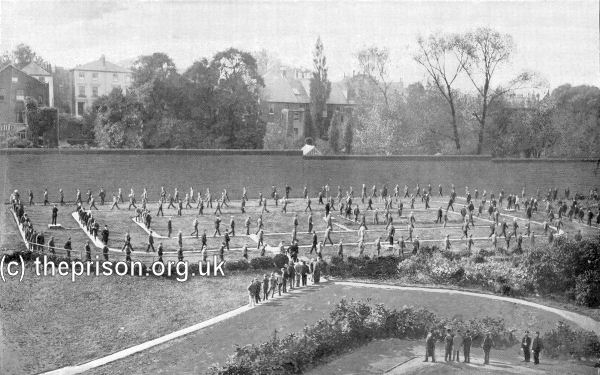
Holloway Prison male exercise yard, London, c.1901. © Peter Higginbotham
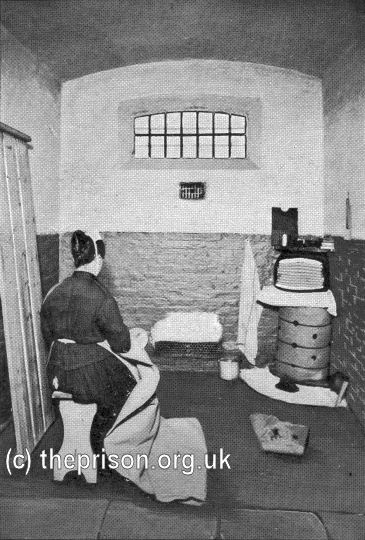
Holloway Prison sack-making, London, c.1901. © Peter Higginbotham
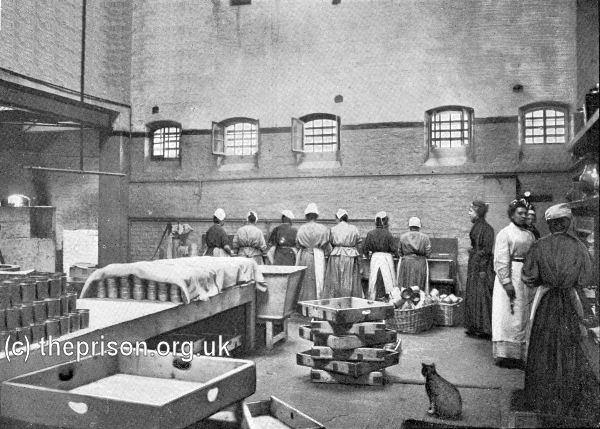
Holloway Prison kitchen, London, c.1901. © Peter Higginbotham
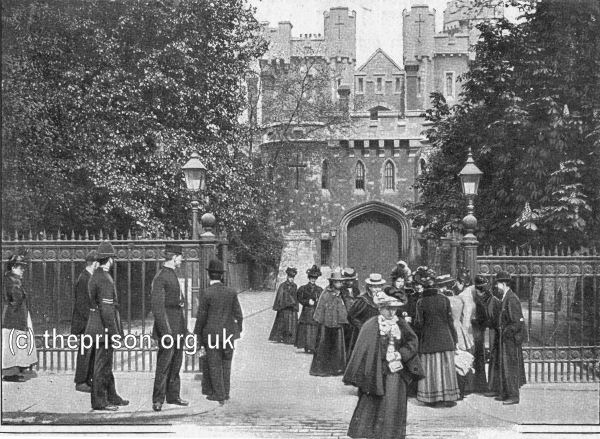
Holloway Prison meeting discharged prisoners, London, c.1901. © Peter Higginbotham
In 1903, following the closure of Newgate, Holloway become a female-only prison. Facilities were provided for mothers with infants, including bedside cots and daytime nurseries.
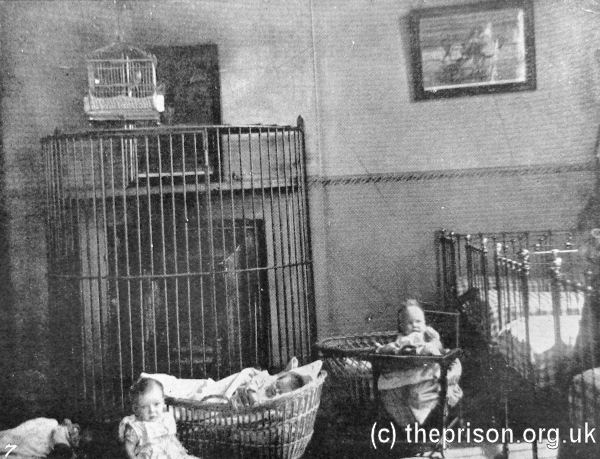
Holloway Prison nursery, London, 1909. © Peter Higginbotham
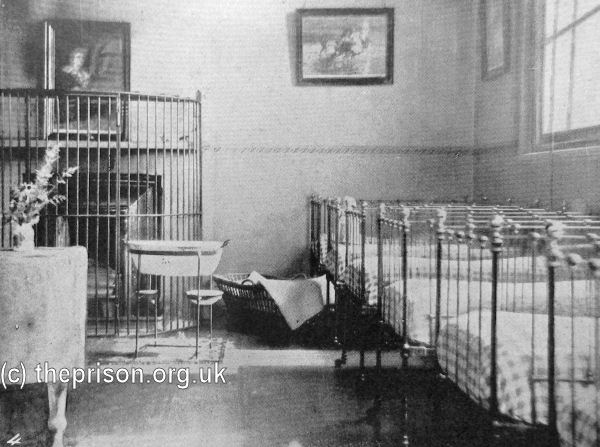
Holloway Prison nursery, London, 1909. © Peter Higginbotham
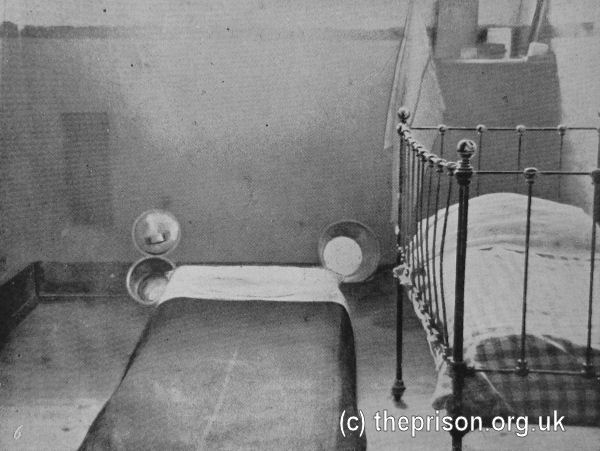
Holloway Prison cot next to mother's plank bed, London, 1909. © Peter Higginbotham
Holloway became well-known for the imprisonment of suffragettes. One of the women's tactics was the hunger strike and in 1909, the use of force-feeding was introduced at the prison.
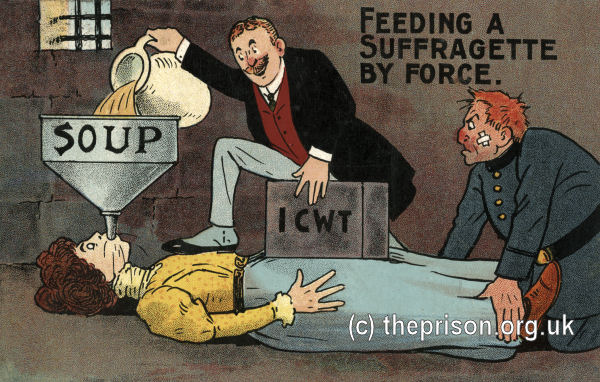
Force-feeding a suffragette, c.1910 © Peter Higginbotham
During the Second World War, the prison was used to intern what were classed as enemy aliens — primarily Germans and Austrians living in the UK, and Nazi sympathizers.
Between 1967 and 1977, the prison was largely rebuilt, with most of the original buildings demolished, included the large turreted gateway. The new accommodation allowed prisoners to be housed in family-style groups of up to sixteen inmates.
The prison was closed in July 2016, with plans to provide housing and other facilities on the site.
Records
Note: many repositories impose a closure period of up to 100 years for records identifying individuals. Before travelling a long distance, always check that the records you want to consult will be available.
- London Metropolitan Archives, 40 Northampton Road, London EC1R OHB. Holding include: Records include: Governor's journals 1948-75; Matron's journals (1933-54); Plans (1846, c.1870); Record of convictions )c.1910-14); Convict nominal registers (1917-64, with gaps); Discharge diaries (1975-84); Holloway Borstal Nominal register (1966-83); Registers of officers (1900-79).
- The National Archives, Kew, Richmond, Surrey, TW9 4DU. Has a wide variety of crime and prison records going back to the 1770s, including calendars of prisoners, prison registers and criminal registers.
- Find My Past has digitized many of the National Archives' prison records, including prisoner-of-war records, plus a variety of local records including Manchester, York and Plymouth. More information.
- Prison-related records on
Ancestry UK
include Prison Commission Records, 1770-1951
, and local records from London, Swansea, Gloucesterhire and West Yorkshire. More information.
- The Genealogist also has a number of National Archives' prison records. More information.
Census
Bibliography
- Camp, John Holloway Prison: The Place and the People (? David & Charles, 1975)
- Beauchamp, Hillary, and Hambling, Maggi Holloway Prison: An Inside Story (Waterside Press, 2010)
- Higginbotham, Peter The Prison Cookbook: A History of the English Prison and its Food (2010, The History Press)
- Brodie, A. Behind Bars - The Hidden Architecture of England's Prisons (2000, English Heritage)
- Brodie, A., Croom, J. & Davies, J.O. English Prisons: An Architectural History (2002, English Heritage)
- Harding, C., Hines, B., Ireland, R., Rawlings, P. Imprisonment in England and Wales (1985, Croom Helm)
- McConville, Sean A History of English Prison Administration: Volume I 1750-1877 (1981, Routledge & Kegan Paul)
- Morris, N. and Rothman, D.G. (eds.) The Oxfod History of the Prison (1997, OUP)
- Pugh R.B. Imprisonment in Medieval England (1968, CUP)
Links
- Prison Oracle - resources those involved in present-day UK prisons.
- GOV.UK - UK Government's information on sentencing, probation and support for families.
Except where indicated, this page () © Peter Higginbotham. Contents may not be reproduced without permission.



